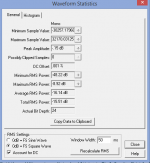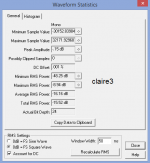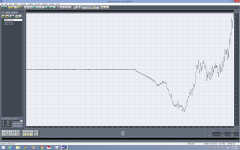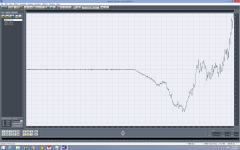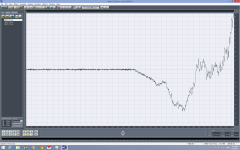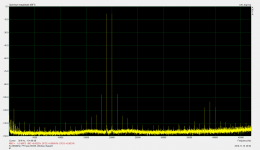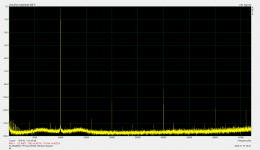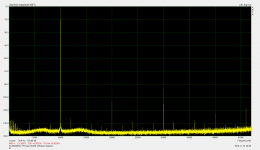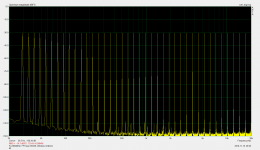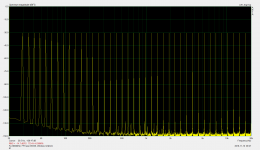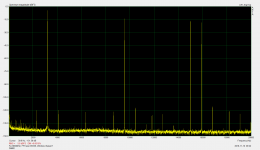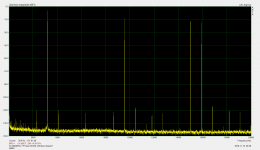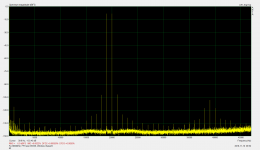The idea that you could accurately hear the difference between two very low distortion systems when played back on a much higher distortion system seems unlikely. ?
Yes, like just about any real speaker.
No offence intended. I apologize if you feel offended.Not clumsy, but rather offensive. For some of us DIY is for fun, what did you or Mark find in my comment to be unkind, close minded or disrespectful? His discernment is at professional level, not the amateur level like I and some others here. The preamp listening test here was useful for us and help in our understanding, but clearly unsuitable for listening at differences in DAC he is interested in. I and Bob speak our mind honestly and politely, I do not think Mark should be offended if we did not immediately bow and adopt his view.
Well, it is not because some of us are able to assemble electronic components ,designing an audio gear, that they (we ?) know more about the mysteries of psycho acoustic and *all* the physical phenomenas in action.
As I had understood Mark4, he was more asking questions, sometimes in an affirmative way, than the contrary.
Not strange I was asking myself exactly the same: How are many of us able to find sonic differences, with what seems some coherency, between 2 or 3 set-ups (here DAC -> preamps-> ADC), from more or less good sources on a technical point of view (distortion and noise lot higher) , with performances of the preamps far beyond what any logic considers as our thresholds of audibility (even listening on a system as rotten as my PC speakers ;-) ?
No harm done Tournesol, contrasting views are part of the fun in DIY, would be rather boring otherwise, nobody is perfect. As I understand it, we have a democratic way of doing things, contrasting opinion is the required fuel for progress, but decision on technical matters has to come from technical merits. We do need to maintain a level head, honesty, politeness and tolerance while commenting for all discussions to gain useful progress. I completely agree that usage of derogatory phrases should be avoided or kept at the minimum to keep emotion from spoiling ongoing discussion.
It is interesting that we could be hearing the difference due to transfer functions of the amps.
I honestly find it strange such question coming from veterans.Not strange I was asking myself exactly the same: How are many of us able to find sonic differences, with what seems some coherency, between 2 or 3 set-ups (here DAC -> preamps-> ADC), from more or less good sources on a technical point of view (distortion and noise lot higher) , with performances of the preamps far beyond what any logic considers as our thresholds of audibility (even listening on a system as rotten as my PC speakers ;-) ?
What if one recording is 0.1dB louder than the other, how will that affect what you hear?
I just would like to mention that there is much much lower difference in level between claire1,2,3 music samples and I am attaching the statistics.
Not strange I was asking myself exactly the same: How are many of us able to find sonic differences, with what seems some coherency, between 2 or 3 set-ups (here DAC -> preamps-> ADC), from more or less good sources on a technical point of view (distortion and noise lot higher) , with performances of the preamps far beyond what any logic considers as our thresholds of audibility (even listening on a system as rotten as my PC speakers ;-) ?
If we are trying to have an open minded approach, we can not exclude any possibility including psychoacoustics. Almost same question of mine, how could some participants of another of my tests hear the difference between 2 files, which were in fact the same and only one of them renamed, and the direct sample difference was just plain zero? Maybe just for the reason that we concentrate to a bit different part of music sample and our hearing is affected and not constant as an analyzer, when making 2 listening trials? Just maybe, but if one calls himself open minded and seeking for truth, he would not exclude this option.
Re PC notebook playback and small PC speakers - is such system able to have repeatedly same performance and parameters? More serious, if two files are almost same but constituted of different sample values due to slightest phase shifts, like C#1 and C#2 have, is a mediocre system able to make a proper analog signal reconstruction from the digital samples, or it introduces its errors seen as digital rubbish in spectrum analysis?
Technically, the biggest difference between C#1-#3 samples, in audio band, is the lowest level background noise. Due to linear transfer function differences, there are also sample value-at-one-time differences apparent after direct file subtraction. What do we hear, in fact? Do we really hear it, are they some reproducing chain imperfections, or is it a plain psychoacoustics? Open mind would ask itself all these questions.
Attachments
Last edited:
His statement made me pause to rethink and redefine my accepted metric to assess audibility. I find a fatalistic view of not measurable as no longer acceptable. With the advance of tools and multitone tests, I really appreciate all work on finding relevant metric currently not being considered and/or measured.I honestly find it strange such question coming from veterans.
If you were a veteran, you should have heard or asked the question decades ago. The problem is not whether it is measurable or not, but whether it is audible or not. This thread proved a point. Pavel for example, were sure he could hear that one amp is more transparent than the other, yet he couldn't prove it with FoobarABX. So how will you setup an experiment that some measures are indeed audible?His statement made me pause to rethink and redefine my accepted metric to assess audibility.
Try this, use no GNFB amp (or lower the feedback) and reduce bias current, and listen again. This might underlined the differences.
His statement made me pause to rethink and redefine my accepted metric to assess audibility. I find a fatalistic view of not measurable as no longer acceptable. With the advance of tools and multitone tests, I really appreciate all work on finding relevant metric currently not being considered and/or measured.
Please find some comparisons between complete claire #1 and #2 path (#3 not used as there is much bigger difference) - DIM, multi, 10k and CCIF in big hires images. Level close to FS or few dB below. Low level plots make no difference.
Attachments
Thank you Pavel, your measurements are always illuminating and helpful.
I'm trained in EE but no audio veteran, just lowly hobbyist. As stated earlier in this thread, I left this hobby alone for years. Many of the tools and techniques have been seriously improved. However relating perception to measurements still remains a work in progress.If you were a veteran, you should have heard or asked the question decades ago. The problem is not whether it is measurable or not, but whether it is audible or not....
Last edited:
I honestly find it strange such question coming from veterans.
Accepting the term 'veteran' as an effect of my old age, let-me try to explain my position.His statement made me pause to rethink and redefine my accepted metric to assess audibility. I find a fatalistic view of not measurable as no longer acceptable. With the advance of tools and multitone tests, I really appreciate all work on finding relevant metric currently not being considered and/or measured.
Any electronic component has what i call a 'character'. So many components in an amplifier. Any schematic has a behavior, specially in the instant dynamic domain. No schematic is exactly the same. Well, with age and experience, as designers and/or 'audiophiles' we tend to prefer this or that, to prefer a brand or an other and have some ideas of their 'character'. The all thing is so complex that, if you avoid to draw hasty and stupid generalizations (like silver is better for treeble), the more you accumulate experiences, often contradictory, the less you are sure of your conclusions.
The only things we can do is to try to find some verified explanations.
Or to remain stuck, like J.C. on things that "works".
Measurements ? One thing is for sure, if they help to eliminate obviously bad performing devices, it do not tell a lot about the way they will "SOUND".
Nothing says that an integrated circuit with the least harmonic distortion will sound best in a given system. And what means "sound best" ?
With experience, as an electronic designer, it seems the more you go, the more you listen, the less you measure. (Because it is faster with ears, and because this game is a make believe, this work that of illusionists. ;-)
Those test are illustrating this position. We have 2 or 3 preamps. Their contribution to distortions and signal noise factor absolutely lost behind the accumulated ones of the all chanel of production/reproduction (scott Wurcer's remark ;-). Despite this, most of us found ... audible differences, and different preferences. And nothing says that our preferences are due to our taste, or our listening systems differences;-).
Let-me try an image. All the stars and planets in the universe obey to the same laws of the gravity, chemistry, nuclear physics. No one is the same. Same thing for individuals in the humanity. See what I mean ?
If you follow a cooking recipe to the letter, every day you will make a dish with a different taste. Their taste will vary even with the meteo. The great chefs adapt their recipes at any moment according to ... what they taste.
Of course, everyone dreams to be able to find the best wine by reading its label and its chemical composition (measurements). But it does not work that way.
So, modestly, relying on luck, after rigorous calculations, but a bit blind, we are constantly trying to create better audio gears, better music records.
And the more we progress, the more refined our perception becomes, and the more the perfection we are trying to achieve seems to move away as we approach it.
Last edited:
If we are trying to have an open minded approach, we can not exclude any possibility including psychoacoustics. Almost same question of mine, how could some participants of another of my tests hear the difference between 2 files, which were in fact the same and only one of them renamed, and the direct sample difference was just plain zero? Maybe just for the reason that we concentrate to a bit different part of music sample and our hearing is affected and not constant as an analyzer, when making 2 listening trials? Just maybe, but if one calls himself open minded and seeking for truth, he would not exclude this option.
Let me repeat myself, please. Would you call yourself open minded, monsieur Tournesol de Château de Moulinsart?
BTW, I like the "reality" like this ;-)
Chateau de Moulinsart — Wikipedia
Le professeur Tournesol
Last edited:
I was intrigued by the Bob Carver challenge. It was stated that a -70dB null was good enough to call two different amps to sound the same. Seems result of a test like the one on this thread is refining some accepted metrics.... Measurements ? One thing is for sure, if they help to eliminate obviously bad performing devices, it do not tell a lot about the way they will "SOUND"....
Last edited:
Most power amps (certainly PA amplifiers) have input level controls and those that don't should have in order to increase system SNR when listening at less than maximum levels.Maybe so, but we could hardly listen to power amps could we? 😉 Presumably we can extrapolate?
Agreed they all sound different and no preamp is best.Pre amps have always had their distinct sound signatures ime, easily telling them apart; revealing their lack of transparency. Which is why, also ime, no pre amp is the best pre amp. And not by a small margin.
My best sounding systems have been the source direct into power amp and using the power amp input level controls to adjust volume.
Dan.
Last edited:
I try the best I can, with my sonotone. I have a lot of doubts, specially about my believes, read my previous post.Let me repeat myself, please. Would you call yourself open minded, monsieur Tournesol de Château de Moulinsart?
I dislike ABX, because I know for sure i'm not able to compare 3 things in the same run. Not enough memory. And, by habit, I only care with obvious subjective results: nothing really obvious for me in those tests, lot of efforts.
If you organized a trap, it was easy for me to fall in: I only listened to the second test once. And everything depends on the order in which I compared them and on which I focused my attention.
I told you that I was not satisfied with the quality of your sources. The displeasure felt in front of their obvious technical flaws, the lack of discriminating informations in the sources (for me) does not helped.
Like choosing between 3 dishes you dislike. or choosing the best lens looking at 3 photos out of focus.
On the second test, I only listened to the percussions. Voices don't interest-me (apart Aretha and very few others ;-), and everything else was awfully recorded/mixed/blurred.
BTW, which samples were the same ?
I would really like you organize an other test with, by example, some samples of the Harry Connick jr record i indicated. Because you will find, in this near perfect recording, near everything we need to test an equipment.
Percussive and credible piano, very natural (a miracle). High overall dynamic, precise and sharp instant dynamic, some parts with single instruments very detailed and silences where you can hear the attacks, the decrease and the room acoustic, some parts with interesting 'sound stage' behind very complex informations of the whole orchestra. Good precise localization (it helps). The only defect is the singer's voice too much in front. (Ego at work ;-)
An other interesting record, in my book, is the piano of Don Pullen. The "Common Ground" title in its last record "Sacred common ground" (zap the boring Indian singing at the start). The only problem with this tune is it is difficult to succeed technical comparisons when you are in tears.
I share those records with an other sound engineer of my friends for our listening tests. With the Commodores title "Night shift" for other reasons. (Oh Lord, what a miracle on my big system, what a miss on the KEF speakers ;-)
With those 3 sources, you got the musicians right in front of you in your listening room, feeling you can touch them, with all the matter, the weight, the little details and ... no questions.
Last edited:
Pavel is correct - one needs to keep an open mind about audible differences - is it truly coming from the device or is it created solely in our brains in the absence of any eternal change in signal.
From what I can gather from this thread, he had a preference for & was sure he could easily identify an audible difference between two circuits which he purposed in the role of preamps. The two circuits don't show differences in measurements which are normally recognised as of audible significance & that would account for his audible preference. AFAIK, Foobar ABX listening tests did not result in results significantly above random results.
So what is the way forward?
From what I can gather from this thread, he had a preference for & was sure he could easily identify an audible difference between two circuits which he purposed in the role of preamps. The two circuits don't show differences in measurements which are normally recognised as of audible significance & that would account for his audible preference. AFAIK, Foobar ABX listening tests did not result in results significantly above random results.
So what is the way forward?
After some researches:C1 and 2 were the same amp, but one was driven balanced the other single ended IIRC
claire1 was recorded through preamp#1 with: J1, J2 = 2SK170BL, IC1 = AD797, IC2 = ADA4898
claire2 was recorded through preamp#1 with: J1, J2 = 2SK170BL, IC1 = AD744, IC2 = ADA4898
claire3 was recorded through pream#2
It usually makes a huge difference when you switch from two devices AC powered and connected together (AC leakages) to both totally isolated (one Battery powered). No more parasitic current noise in the ground reference between them.
If the differences i found were not created by some auto suggestions, or perturbations on my AC power (working day VS week-end), it says that i prefered AD797 to the AD744 ?
0.000001% Total Harmonic Distortion, 20 V/µs Slew Rate
VS
0.0003% Total Harmonic Distortion (THD), 75 V/µs Slew Rate
Am-i able to hear such low levels of distortions differences on my cheap PC speakers ? Not convinced.
Time to make an other listening of the claire files, more concentrated, with fresher ears. This time on headphones.
My conclusion of the day ? All of them sound better than last night. If i had to choose between the 3 ? I would chose ... the less expensive. I don't give a damn with the differences if any.
Another way to express my previous conclusion:
"None of those 3 files are 'analytic' enough for me to make a decision about the hardware."
Preferring one device between two identical ones makes no harm ;-)Pavel is correct - one needs to keep an open mind about audible differences - is it truly coming from the device or is it created solely in our brains in the absence of any eternal change in signal.
- Home
- General Interest
- Everything Else
- Can you hear a difference between 2 solid state preamps?

